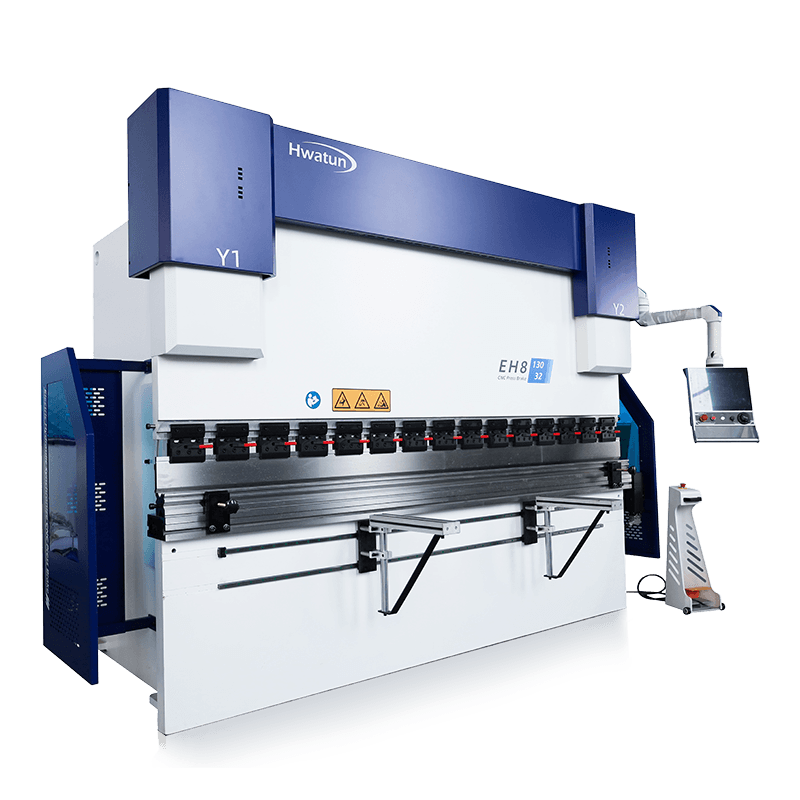Web Menu
Product Search
Exit Menu
How to ensure the precision and processing quality of CNC PRESS BRAKE?
The precision and processing quality of CNC press brakes are crucial to the quality of products during the production process. In order to ensure the precision and processing quality of CNC press brakes, it is usually necessary to ensure and control from the following aspects:
1. CNC system and control accuracy
The core of CNC press brakes is its control system. A high-precision CNC system can ensure that various parameters in the bending process can be accurately controlled. The system accurately controls the operation of the machine according to the set parameters (such as bending angle, pressure, speed, etc.) through calculation and programming.
Position control accuracy: CNC press brakes are usually equipped with high-precision servo motors, linear guides and encoders to provide precise positioning control. Through the CNC system, the operator can input precise bending angles and dimensions, and the machine will adjust according to these instructions to ensure that each bend is accurate to the specified position.
Angle control: By automatically adjusting the bending angle and pressure, the CNC press brake can maintain a consistent angle at multiple bending positions, thereby improving the overall accuracy of the product.
2. Stability of the hydraulic system
The hydraulic system is used in CNC press brakes to provide the pressure required for bending. If the stability of the hydraulic system is not good, it will directly affect the bending accuracy and processing quality. In order to ensure the accuracy of the hydraulic system:
Pressure control system: The high-precision pressure control system can ensure that the bending machine applies uniform pressure throughout the operation process. The stability of the hydraulic system ensures that each workpiece can be evenly pressurized, thereby ensuring the bending accuracy.
High precision of hydraulic pumps and valves: The use of high-precision hydraulic pumps and valves ensures that the system can respond quickly during operation without pressure fluctuations, ensuring stable bending force.
3. Matching of molds and workpieces
The selection of molds and the clamping method of workpieces directly affect the accuracy of processing. For CNC bending machines, the design and installation of molds are crucial:
Mold design: The precision requirements of bending molds are very high. The installation, wear and regular replacement of molds must be strictly controlled to ensure that the geometry of the molds is always accurate, thereby ensuring the stability of the bending angle and surface quality.
Mold material: High-quality mold materials can effectively extend the service life of the mold and reduce the slight deformation that may occur during the bending process to avoid affecting the accuracy.
Gap adjustment of the die: Use different die gaps on materials of different thicknesses and hardnesses to ensure that the material will not deform or crack during the bending process, thereby improving processing accuracy.
4. Automatic centering and workpiece positioning
Accurate workpiece positioning is essential to ensure bending accuracy. CNC bending machines are usually equipped with some automatic centering and workpiece positioning systems:
Automatic centering system: This technology ensures that the position of the material is always accurate during the bending process. Using laser sensors, optical alignment or mechanical positioning devices, you can ensure that the workpiece is accurately aligned and prevent deviation.
Back gauge device: The accuracy of the back gauge device affects the bending angle and position. The accurate back gauge system can automatically adjust the position according to the set size to avoid bending deviation caused by workpiece movement or misalignment.
5. Control of workpiece material properties
Different materials have different bending properties, such as elasticity, hardness, ductility, etc. These properties will affect the bending accuracy. Therefore, in the process of ensuring bending accuracy, it is necessary to control the characteristics of the material:
Control of material thickness and hardness: The CNC bending machine will adjust according to the thickness and hardness of different materials to ensure that the appropriate bending force is provided. Through high-precision pressure control, the processing quality can be avoided from being affected by excessive or insufficient pressure.
Pretreatment of materials: Some materials may need to be preheated or annealed to reduce the internal stress that may occur during the bending process, thereby improving the stability and accuracy after bending.
6. Temperature control
Temperature changes may cause the expansion or contraction of the internal components of the bending machine, thereby affecting the accuracy of the bending. In order to reduce this effect, many high-precision CNC bending machines are equipped with a temperature control system to keep the machine working within a stable temperature range:
Cooling system: Through liquid cooling or air cooling system, the temperature changes of the hydraulic system and electrical components can be reduced, the system can be kept stable, and the accuracy deviation caused by thermal expansion can be reduced.
Heating system: For some special materials, the bending machine may also be equipped with a heating device to ensure that the material reaches the optimal temperature during the bending process, thereby improving the bending accuracy.
Through the comprehensive application of these measures, the processing accuracy of the CNC bending machine can be greatly improved, ensuring that each workpiece meets high standards of quality requirements.
News categories
Product categories
Related Products
 +86-159 5138 1316
+86-159 5138 1316 +86 180 6819 3096
+86 180 6819 3096 [email protected]
[email protected] Group 4, Xinba Village, Binhai New Area (jiaoxie Town), Laoba Port, Nantong City, Jiangsu, China.
Group 4, Xinba Village, Binhai New Area (jiaoxie Town), Laoba Port, Nantong City, Jiangsu, China.
Copyright © Nantong Hwatun Heavy Machine Tool Co., Ltd. All Rights Reserved.

 Eng
Eng  简体中文
简体中文 Español
Español русский
русский







